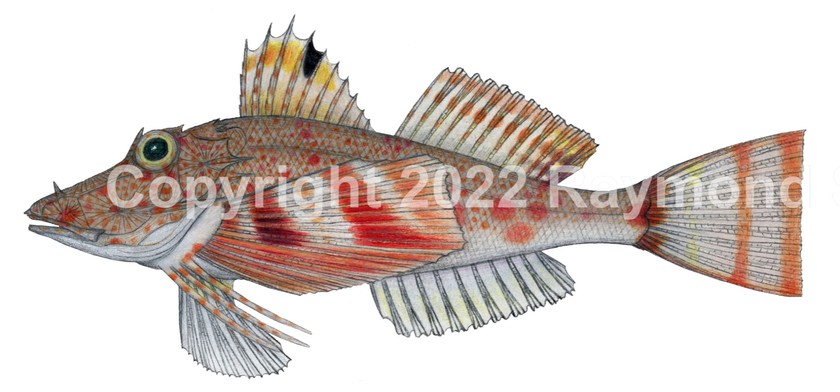
Common Name
Bean's Searobin
Year Described
Goode, 1896
Identification
Dorsal Fin: X, 11-12
Anal Fin: 10
Pectoral Fin: 13-14
Body relatively stout but elongate and slightly compressed . Head is large, bony, and heavily sculptured with pronounced ridges and spines. Head relatively deep. Duck-billed snout is long. Mouth is subterminal and small in size, containing bands of villiform teeth on the jaws, vomer, and palatines. Jaw is well short of eye. No spines at nostrils. Preopercle and opercle usually bear strong spines. Preopercular spine reaches edge of opercle. Large, fan-like pectoral fins with strongly branched rays, with the lower three rays free, thickened, and separate from the fin membrane. Pectoral fin viewed from above squared off anteriorly ad posteriorly, with a straight to concave outer margin (overall giving a triangular shape). Pectorals when folded reach middle of anal fin base. Two dorsal fins: one spiny and one soft rays. Anal fin opposite soft dorsal fin. Caudal fin is truncate. Pelvic fin underneath pectoral fin on belly. Body covered in small ctenoid scales with the exception of the naked ventral surface. Chest and throat scaled. Nape scaled. Opercular membrane above spine partially scaled. Lateral line is continuous.
Color
Body and head gray with red or red-orange mottling, spots and blotches. Blotches can form irregular bars, especially under the dorsal fins. Spiny dorsal fin with a ocellated spot between spines 4-5. Dorsal fins pale yellowish or cream with reddish or orange spot-bands. Pectoral fin dark red with a dominant whitish center band running from the middle of the rear margin to the tip of the fin. There are a few other thinner whitish bands on the posterior 2/3 of the fin. The anterior third of fin plain reddish with white rays. Anal fin pale reddish with a white margin. Pelvic fin cream to reddish. Caudal fin cream with three distinct reddish or orange-red bands.
Size
Maximum size to 15cm SL.
Habitat
Soft bottoms from 55-274m (usually 46-128m).
Range
Continental coast from Honduras to S. Brazil.
References
Carvalho-Filho, A. 2023. Fishes of the Brazilian coast. Literare Books International, São Paulo: 1-424.
Richards, W. J. & G. C. Miller. 2003. Triglidae (pp. 1266-1277). In: Carpenter, K. E. (ed.) 2003. The living marine resources of the Western Central Atlantic. Volume 2: Bony fishes part 1 (Acipenseridae to Grammatidae). FAO species identification guide for fishery purposes and American Society of Ichthyologist and Herpetologists Special Publication No. 5. FAO, Rome. v. 2: i-vii + 602-1373.